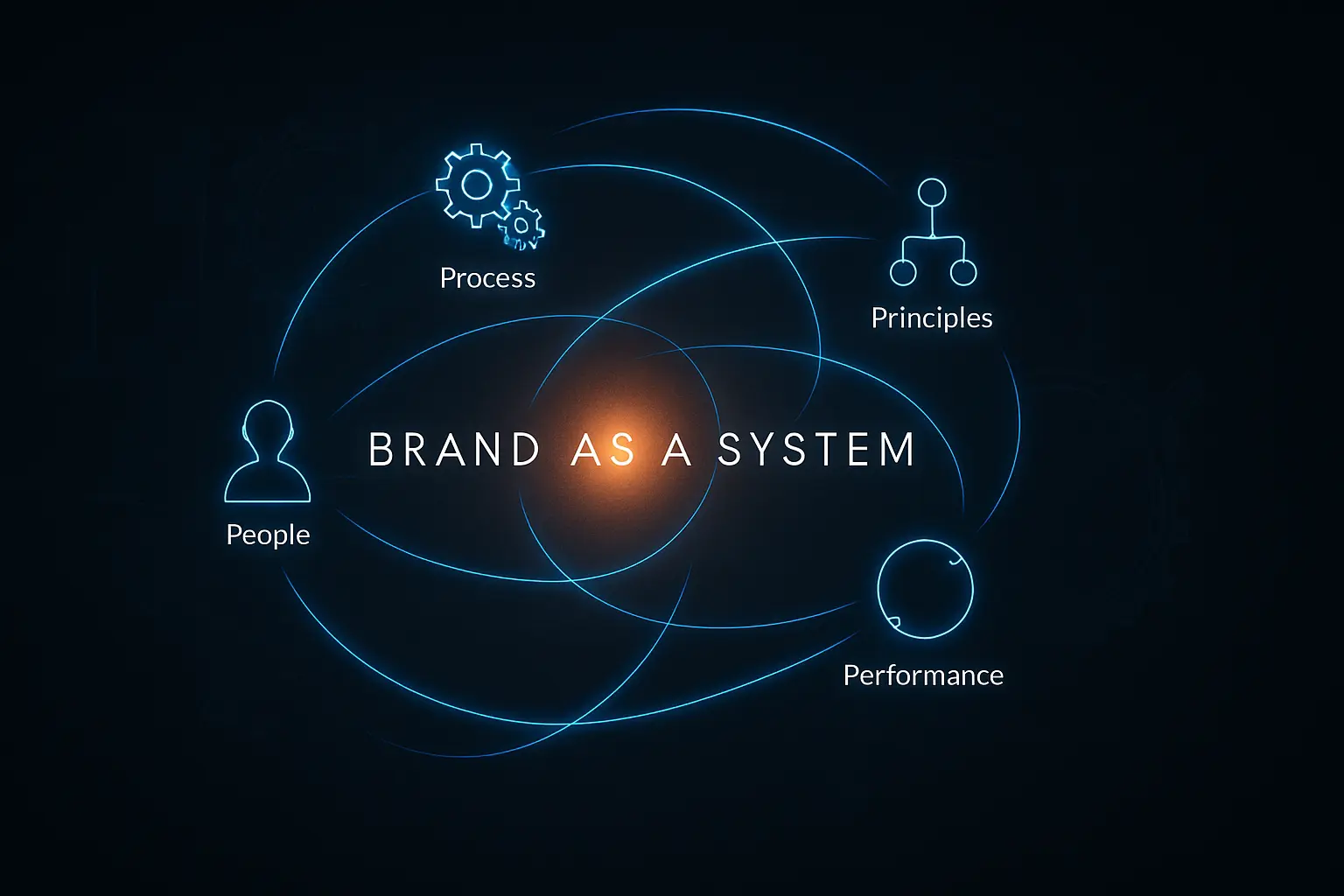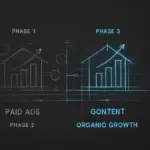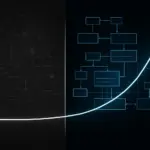A few years ago, I reviewed a proposal from our marketing team at JvG Technology. It was for a major trade show, and while everything looked perfect on the surface—the right logos, the correct color codes—the language felt off.
It was technically correct but lacked the voice of a confident engineering partner. It spoke at potential clients, not with them. The static brand guide we’d paid a fortune for was followed to the letter, but it had failed to convey the intent. The system was technically working, but it was culturally broken.
That experience crystallized a problem I’d seen across all my ventures: traditional brand guides are dead. They are static documents in a dynamic world. They tell you what colors to use but not how to make a decision when faced with a new marketing channel. They are rulebooks, not operating systems.
The search for a better way led me to reframe the entire concept: a brand isn’t a set of assets to be guarded; it’s a system to be run. It’s an operating system (OS) that enables consistent, scalable decision-making by everyone in the company.
Building this OS is one of the highest-leverage activities a founder can undertake, especially since research consistently shows that brand consistency can lift revenue by up to 33%. This isn’t about aesthetics; it’s about performance.
Beyond the PDF: Why Static Brand Guides Fail
Most companies operate with a brand guide that sits in a forgotten Dropbox folder. It’s a relic, created once and rarely updated. And that’s the gap—the one I see exploited by countless agencies selling beautiful but useless documents.
Competitors talk a good game about “living brand systems,” but their content remains abstract and theoretical. They define the “what” but never show you the “how”—the messy, hands-on reality of building and running such a system.
They miss the most critical part: the friction. They don’t talk about what happens when your AI-powered copywriting tool spits out something that’s on-brand but tone-deaf, or when a salesperson has to break script to close a crucial deal.
A Brand OS, as I build it, is different. It’s not a document; it’s a collection of interconnected loops, principles, and processes that blend human judgment with intelligent automation. It is designed to evolve.
The Architecture of My Brand OS
To make this tangible, my Brand OS is structured around five core layers. This isn’t just a framework; it’s the active architecture we use to guide everything from high-level strategy at JvG Technology to daily ad copy experiments at Mehrklicks.
1. Purpose (The Kernel)
This is the core mission: Why does the business exist beyond making money? For JvG Technology, it’s about accelerating the global transition to sustainable energy. This purpose acts as the ultimate filter for every decision. If an action doesn’t align with the kernel, the OS rejects it.
2. Principles (The API)
Principles are the strategic rules that guide behavior. They are the “if-then” statements of our brand. For example: “We communicate with the precision of an engineer and the clarity of a teacher.” This principle is a tool that empowers a team member to write an email, design a presentation, or handle a client call without consulting a 100-page manual. It’s an API for our brand’s logic.
3. People (The Users)
A system is useless if its users don’t adopt it. This layer is about training, feedback, and culture. How do we onboard new team members into the system? How do we create feedback loops where a junior marketer can flag when a process is generating off-brand results? It involves creating a culture where people feel like owners of the brand, not just renters.
4. Process (The Workflow)
Here, automation and human oversight meet. This is the set of workflows for creating content, running campaigns, and managing communications. For example, our content creation process uses an AI assistant for initial drafts (speed) but requires a human strategist for the final edit and contextual framing (judgment). The process defines the hand-off points between machine and human.
5. Performance (The Feedback Loop)
How do we know the OS is working? This layer is about measurement. We track metrics for brand consistency, message resonance, and, ultimately, revenue. But we also gather qualitative data. When a customer says, “Your team just gets us,” that’s a sign the OS is performing correctly. This data feeds back into the system, allowing it to adapt and improve—a core component of systems thinking in practice.
Field Notes: The System in Action
The theory is clean, but the reality is messy. This is where the real work happens—testing the limits of the system, observing where it breaks, and documenting the learnings. These are not case studies; they are live dispatches from the front lines of building a Brand OS.
Over time, I’ll be documenting these experiments in a series of “Field Notes.” Here are some of the questions we’re actively working through:
-
Drawing the Automation Line: We’re constantly tuning our sales outreach. How much of the process can be automated before we lose the human touch that builds real trust? We’re documenting our experiments in “How I Draw the Automation Line in Our Sales Process.”
-
Human Oversight Systems: We deployed an AI model to predict customer churn. It works 90% of the time, but the 10% it gets wrong are our most valuable customers. The lesson? Every AI loop needs a human heartbeat to catch the edge cases. We explore this in “Why Our AI Loop Needs a Human Heartbeat.”
-
Failure Analysis: Last month, a broken Zapier connection took down our lead nurturing workflow for 48 hours. The failure taught us more about resilience than a year of smooth operation. I’m breaking that down in “The Day Our Workflow Broke: Lessons in System Resilience.”
-
Cultural Effects: We gave our support team a powerful set of AI-generated response templates. Efficiency soared, but customer satisfaction dipped. We realized the automation was killing curiosity. We’re sharing that story in “When Automation Killed Curiosity, and How We Fixed It.”
These notes form the core of my founder’s operating system—a living library of what works, what doesn’t, and why.
The Human in the Machine
This all points to the most important principle: a Brand OS is not about replacing human judgment. It’s about amplifying it. It automates the repetitive and codifies the proven, freeing our people to focus their energy on the complex, nuanced challenges where they create the most value.
An AI can check for brand colors, but it can’t feel when a message is emotionally resonant. A workflow can schedule posts, but it can’t decide to scrap the entire content calendar in response to a major world event.
The goal is to build a hybrid system where machines provide speed and scale, while humans provide context, empathy, and strategic oversight. The system handles the knowns; the humans handle the unknowns.
Frequently Asked Questions
Isn’t this over-engineering what should be a creative process?
Quite the opposite. By systematizing the 80% of brand work that is repeatable, you free up creative energy for the 20% that truly matters. A solid OS gives creatives a stable platform to do their best work, not a cage of rules. It removes cognitive load.
How do you get a team to actually adopt and use a Brand OS?
You don’t launch it; you co-create it. We build our OS iteratively with the teams that use it. We start with one small, high-pain process, fix it together, and document the principle. Adoption happens naturally when the system makes someone’s job demonstrably easier and their work more effective.
What’s the first step to building a Brand OS if you’re starting from scratch?
Start with the “Principles” layer. Forget logos and colors for a moment. Sit down with your team and codify three to five principles that guide your decisions. For example, “We always sacrifice speed for quality” or “We communicate with radical transparency.” These principles are the seeds of your entire operating system.
A brand system isn’t a rulebook; it’s a compass for decision-making. Its purpose is to ensure that anyone acting on the brand’s behalf makes decisions that are coherent, consistent, and aligned with the core mission. It’s the difference between a team following a map and a team that knows how to read the stars.




